
Krembo
Encyclopedia
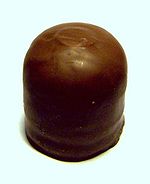
Chocolate
Chocolate is a raw or processed food produced from the seed of the tropical Theobroma cacao tree. Cacao has been cultivated for at least three millennia in Mexico, Central and South America. Its earliest documented use is around 1100 BC...
-coated marshmallow
Marshmallow
The marshmallow is a confection that, in its modern form, typically consists of sugar, corn syrup, water, gelatin that has been softened in hot water, dextrose, vanilla flavourings, and sometimes colouring, whipped to a spongy consistency. Some marshmallow recipes call for egg whites...
treat was created about 200 years ago in Denmark
Denmark
Denmark is a Scandinavian country in Northern Europe. The countries of Denmark and Greenland, as well as the Faroe Islands, constitute the Kingdom of Denmark . It is the southernmost of the Nordic countries, southwest of Sweden and south of Norway, and bordered to the south by Germany. Denmark...
.
Chocolate teacake
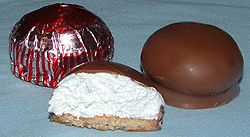
although a teacake
Teacake
This article is about a type of bread or cake. Tea cake can also be used to describe Compressed tea. For the chocolate-covered teacake, see Chocolate-coated marshmallow treats....
in England is usually a sweet bread roll
Bread roll
A bread roll is a piece of bread, usually small and round and is commonly considered a side dish. Bread rolls are often used in the same way as sandwiches are—cut transversely, with fillings placed between the two halves.-Various forms:...
with dried fruit
Dried fruit
Dried fruit is fruit where the majority of the original water content has been removed either naturally, through sun drying, or through the use of specialized dryers or dehydrators. Dried fruit has a long tradition of use dating back to the fourth millennium BC in Mesopotamia, and is prized...
which is served toast
Toast
Toast is bread that has been browned by exposure to radiant heat. This browning reaction is known as the Maillard reaction. Toasting warms the bread and makes it firmer, so it holds toppings more securely...
ed and butter
Butter
Butter is a dairy product made by churning fresh or fermented cream or milk. It is generally used as a spread and a condiment, as well as in cooking applications, such as baking, sauce making, and pan frying...
ed. There are several manufacturers of chocolate teacakes in the UK, though the best known is Tunnock's
Tunnock's
Thomas Tunnock Limited, commonly known as Tunnock's, is a family baker in Uddingston, Scotland.The company was formed by Thomas Tunnock as Tunnock's in 1890, when he purchased a baker's shop in Uddingston. The company expanded in the 1950s, and it was at this time that the core products were...
, a Scottish company founded in 1890. The Tunnock's teacake is commonly regarded in the same food category as the British biscuit
Biscuit
A biscuit is a baked, edible, and commonly flour-based product. The term is used to apply to two distinctly different products in North America and the Commonwealth Nations....
, eaten at break times with a cup of tea as shown in advertising for the product.
The Tunnock's Teacake enjoys iconic status in Scotland, evoking memories of childhood, or symbolizing "home" for Scots around the world. The Scottish National Blood Transfusion Service
Scottish National Blood Transfusion Service
The Scottish National Blood Transfusion Service is the national blood, blood product and tissue provider of Scotland. It is a special health board of the Scottish National Health Service.-History:...
gives Tunnock's Teacakes to blood donors in Scotland after giving blood. There is an online appreciation society for the Tunnock's Teacake and Dundee University also has an appreciation society for the Tunnocks Teacake. A giant fully edible replica of a Tunnocks Teacake was made by Michelle Kershaw and Nick Dodds at Pimp That Snack
Pimp That Snack
Pimp That Snack is a website which received media attention during April 2006. The website features guides on creating giant versions of everyday snacks...
.
The product itself consists of a small round shortbread
Shortbread
Shortbread is a type of unleavened biscuit which is traditionally made from one part white sugar, two parts butter, and three parts oatmeal flour. The use of plain white flour is common today, and other ingredients like ground rice or cornflour are sometimes added to alter the texture...
base covered with a hemisphere of Italian meringue, a whipped egg white
Egg white
Egg white is the common name for the clear liquid contained within an egg. In chickens it is formed from the layers of secretions of the anterior section of the hen's oviduct during the passage of the egg. It forms around either fertilized or unfertilized egg yolks...
concoction similar to marshmallow
Marshmallow
The marshmallow is a confection that, in its modern form, typically consists of sugar, corn syrup, water, gelatin that has been softened in hot water, dextrose, vanilla flavourings, and sometimes colouring, whipped to a spongy consistency. Some marshmallow recipes call for egg whites...
. As this soft white fondant is based on egg white rather than gelatine, it is much more delicate than marshmallow. This is then coated in a thin layer of milk or plain chocolate
Chocolate
Chocolate is a raw or processed food produced from the seed of the tropical Theobroma cacao tree. Cacao has been cultivated for at least three millennia in Mexico, Central and South America. Its earliest documented use is around 1100 BC...
and, in the case of Tunnock's, wrapped in a distinctive red and silver foil for the more popular milk chocolate variety, and a blue and gold wrapping for the plain chocolate type.
The argument about whether the teacake is a biscuit or a cake led to an action in the European Court of Justice
European Court of Justice
The Court can sit in plenary session, as a Grand Chamber of 13 judges, or in chambers of three or five judges. Plenary sitting are now very rare, and the court mostly sits in chambers of three or five judges...
by British company Marks and Spencer who argued that it had wrongly been classed as a biscuit and taxed by the UK government as such. The European court ruled that the Teacake was not, in fact, a biscuit but a cake and as such Marks and Spencer have begun a legal battle in the UK to retrieve the taxes paid which could amount to as much as 3.5 million UK pounds sterling ($5.6 million).
Flødebolle/Negerbolle/Negerkys
In Denmark the confection is known as a flødebolle (cream bun), negerbolle (negro bun) or negerkys (negro kiss). As of The early 2000s, the "negro" names have been phased out by all major producers, as it is not seen as politically correct. Denmark also markets a variation shaped more like a patty, hence the name bøf (steak).Denmark is arguably the largest producer of chocolate-coated marshmallow treats, producing approximately 800 million of these every year. The largest producer, Elvirasminde, produces roughly 650 million treats, sending 400 million abroad and leaving the remaining 250 million to be eaten by the Danish population, putting the amount of flødeboller eaten at 45 per Dane per year.
Krembo
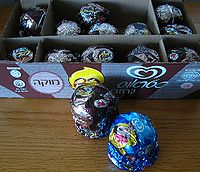
Krembo
Chocolate-coated marshmallow treats are produced in different variations around the world, with several countries claiming to have invented it or hailing it as their "national confection." The first chocolate-coated marshmallow treat was created about 200 years ago in Denmark.-Chocolate teacake:In...
is very popular in Israel, especially in the winter as an alternative to ice-cream. It comes wrapped in colourful aluminium foil
Aluminium foil
Aluminium foil is aluminium prepared in thin metal leaves, with a thickness less than , thinner gauges down to are also commonly used. In the USA, foils are commonly gauged in mils. Standard household foil is typically thick and heavy duty household foil is typically .The foil is pliable, and...
, and consists of a round biscuit
Biscuit
A biscuit is a baked, edible, and commonly flour-based product. The term is used to apply to two distinctly different products in North America and the Commonwealth Nations....
base on the bottom and whipped egg whites cream from above, coated in a thin layer of chocolate
Chocolate
Chocolate is a raw or processed food produced from the seed of the tropical Theobroma cacao tree. Cacao has been cultivated for at least three millennia in Mexico, Central and South America. Its earliest documented use is around 1100 BC...
. There are vanilla
Vanilla
Vanilla is a flavoring derived from orchids of the genus Vanilla, primarily from the Mexican species, Flat-leaved Vanilla . The word vanilla derives from the Spanish word "", little pod...
and mocha flavoured Krembos. In Hebrew, the word krembo is a combination of krem (cream) and bo (in it). The average krembo weighs 25 grams (0.882 ounces) and has 115 calorie
Calorie
The calorie is a pre-SI metric unit of energy. It was first defined by Nicolas Clément in 1824 as a unit of heat, entering French and English dictionaries between 1841 and 1867. In most fields its use is archaic, having been replaced by the SI unit of energy, the joule...
s. In Israel, the "krembo season" is from October to February. 50 million krembos are sold each year—an average of 9 per person in Israel. According to a study funded by Strauss, Israel's leading krembo producer, 69% of Israelis prefer to eat krembos from the top down (starting with the cream), and only 10% start with the biscuit at the bottom; the rest had no preference. Krembos are exported to the United States and Canada, and sold mostly in kosher shops and import stores. The concoction was popular as a homemade sweet in Mandate Palestine
Palestine
Palestine is a conventional name, among others, used to describe the geographic region between the Mediterranean Sea and the Jordan River, and various adjoining lands....
in the 1940s, when it was known as Kushi
Kushi
are skewers used in Japanese cuisine to hold and pierce food for grilling and frying, such as yakitori. They range in length from about 15 to 30 cm. Kushi may be made of steel, bamboo, or wood. The steel and wooden varieties are reusable, while those made from bamboo are usually only used...
(Hebrew
Hebrew language
Hebrew is a Semitic language of the Afroasiatic language family. Culturally, is it considered by Jews and other religious groups as the language of the Jewish people, though other Jewish languages had originated among diaspora Jews, and the Hebrew language is also used by non-Jewish groups, such...
: כושי, "negro"). It entered mass production in 1966. The first manufacturer, the Whitman Company, coined the name Krembo. A mocha flavour was introduced in 1967. In 1979 Whitman was acquired by Strauss-Elite
Strauss-Elite
Strauss Group Ltd. formerly known as Strauss-Elite , is a food products manufacturer in Israel. It is the shared trademark of two companies - Strauss and Elite, that merged in 2004...
. Today Strauss controls 54% of the krembo market in Israel. In 2007, Nestlé
Nestlé
Nestlé S.A. is the world's largest food and nutrition company. Founded and headquartered in Vevey, Switzerland, Nestlé originated in a 1905 merger of the Anglo-Swiss Milk Company, established in 1867 by brothers George Page and Charles Page, and Farine Lactée Henri Nestlé, founded in 1866 by Henri...
introduced an ice cream variation of krembo called Lekbo (Hebrew
Hebrew language
Hebrew is a Semitic language of the Afroasiatic language family. Culturally, is it considered by Jews and other religious groups as the language of the Jewish people, though other Jewish languages had originated among diaspora Jews, and the Hebrew language is also used by non-Jewish groups, such...
: לקבו, "lick inside"). In the Hebrew version of Harry Potter and the Philosopher's Stone
Harry Potter and the Philosopher's Stone
Harry Potter and the Philosopher's Stone is the first novel in the Harry Potter series written by J. K. Rowling and featuring Harry Potter, a young wizard...
, Dumbledore's favourite sweet is a Krembo, rather than a sherbet lemon. The Krembo has become a pop-cultural/national icon. While considered a children's favourite, sociologists have found that it is consumed as a comfort food
Comfort food
Comfort food is food prepared traditionally that may have a nostalgic or sentimental appeal. Comfort foods may be foods that have a nostalgic element either to an individual or a specific culture...
by Israeli expatriates in the United States.
Mallomars
In the US, Mallomarsare produced seasonally at Nabisco
Nabisco
Nabisco is an American brand of cookies and snacks. Headquartered in East Hanover, New Jersey, the company is a subsidiary of Illinois-based Kraft Foods. Nabisco's plant in Chicago, a production facility at 7300 S...
. A graham cracker
Graham cracker
The graham cracker was developed in 1829 in Bound Brook, New Jersey, by Presbyterian minister Rev. Sylvester Graham. The true graham cracker is made with graham flour, a combination of fine-ground white flour and coarse-ground wheat bran and germ. Graham crackers are often used for making s'mores...
circle is covered with a puff of extruded marshmallow, then enrobed
Enrober
An enrober is a machine used in the confectionery industry to coat a food item with a coating medium, typically chocolate. Foods coated by enrobers include nuts, ice cream, toffee and other miscellaneous candy items, biscuits and cookies. Enrobing is essentially a mechanized form of hand-dipping...
in dark chocolate, which forms a hard shell. Mallomars were introduced to the public in 1913, the same year as the Moon Pie
Moon pie
A moon pie or MoonPie is a pastry which consists of two round graham cracker cookies, with marshmallow filling in the center, dipped in chocolate or other flavors. The traditional pie is about three inches in diameter...
(a confection which has similar ingredients). The first box of Mallomars was sold in West Hoboken, NJ (now Union City, NJ). Nabisco discusses it with a short story printed on Mallomar boxes.
Mallomars are generally available from early October through to April. They are not distributed during the summer months, supposedly because they melt easily in summer temperatures, though this is as much for marketing reasons as for practical ones. Devoted eaters of the cookie have been known to stock up during winter months and keep them refrigerated over the summer, although Nabisco markets other fudge-coated cookie brands year-round. Seventy percent of all Mallomars are sold in metropolitan New York
New York City
New York is the most populous city in the United States and the center of the New York Metropolitan Area, one of the most populous metropolitan areas in the world. New York exerts a significant impact upon global commerce, finance, media, art, fashion, research, technology, education, and...
. The issue of Nabisco's choice to release Mallomars seasonally became a parodied topic on a sketch delivered by graphic artist Pierre Bernard on Late Night with Conan O'Brien
Late Night with Conan O'Brien
Late Night with Conan O'Brien is an American late-night talk show hosted by Conan O'Brien that aired 2,725 episodes on NBC between 1993 and 2009. The show featured varied comedic material, celebrity interviews, and musical and comedy performances. Late Night aired weeknights at 12:37 am...
.
According to the box, Mallomars are made in Canada by Kraft Foods.
In Canada, these are known as "Dream Puffs."
Mohrenkopf
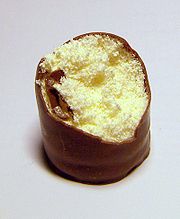
Switzerland
Switzerland name of one of the Swiss cantons. ; ; ; or ), in its full name the Swiss Confederation , is a federal republic consisting of 26 cantons, with Bern as the seat of the federal authorities. The country is situated in Western Europe,Or Central Europe depending on the definition....
, they are commonly known as Mohrenköpfe (Moor's heads), it's one of the European countries that still uses the original term. In the French speaking part of Switzerland they are known as Têtes Choco ("chocolate heads").
Neekerinsuukot (Negerkyss)
In FinlandFinland
Finland , officially the Republic of Finland, is a Nordic country situated in the Fennoscandian region of Northern Europe. It is bordered by Sweden in the west, Norway in the north and Russia in the east, while Estonia lies to its south across the Gulf of Finland.Around 5.4 million people reside...
, the name originated from Germany, and they were named "Negro Kisses" in 1951. In 2001, their name was changed to "Brunberg's Kisses", after the manufacturer, for largely the same reasons as in Denmark.
Negerzoenen
In the NetherlandsNetherlands
The Netherlands is a constituent country of the Kingdom of the Netherlands, located mainly in North-West Europe and with several islands in the Caribbean. Mainland Netherlands borders the North Sea to the north and west, Belgium to the south, and Germany to the east, and shares maritime borders...
the name is Negerzoenen ("Negro kisses") or moorkoppen ("Moors' heads") though some companies have changed the name to the more politically correct
Political correctness
Political correctness is a term which denotes language, ideas, policies, and behavior seen as seeking to minimize social and institutional offense in occupational, gender, racial, cultural, sexual orientation, certain other religions, beliefs or ideologies, disability, and age-related contexts,...
Zoenen ("Kisses") reportedly due to claims of racism, similar to the German case where Negerkuss was renamed to Schokoküsse,
while actually the name-change was made for marketing reasons.
Schokokuss / Mohrenkopf / Negerkuss / Vollidiot (without marshmallow)
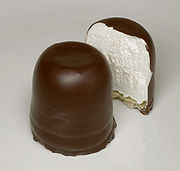
Germany
Germany , officially the Federal Republic of Germany , is a federal parliamentary republic in Europe. The country consists of 16 states while the capital and largest city is Berlin. Germany covers an area of 357,021 km2 and has a largely temperate seasonal climate...
dates back to 1829. The sweets are sold all year long. Every year approximately one billion are sold. This makes an average of about one dozen per person per year. They are available in supermarkets, many bakeries and some schools. Sometimes they are consumed pressed between two halves of a bun, which is also referred to as a Matschbrötchen ("Squished Bread Roll")–mostly by children.
These sweets are made of sweetened egg white foam and not marshmallows. In most cases the used sweetener is sugar, but there are also sugar-free products with sugar substitutes on the German market. The consistency is quite fluffy and not sticky or gooey.
They were first only known under the names Mohrenkopf ("Moor's Head") or Negerkuss ("Negro's Kiss"), but most companies changed the official product-name in the 1980s to the more neutral Schokokuss ("Chocolate Kiss"), Schaumkuss ("Foam Kiss") or to brand-specific names (the most famous brand being Dickmann's). In the South and the West of Germany they are still commonly known as Mohrenkopf. In Austria they are referred to as Schwedenbomben ("Swedish bombs").
Whippets
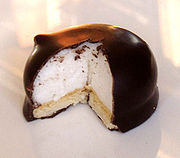
Montreal
Montreal is a city in Canada. It is the largest city in the province of Quebec, the second-largest city in Canada and the seventh largest in North America...
, Quebec
Quebec
Quebec or is a province in east-central Canada. It is the only Canadian province with a predominantly French-speaking population and the only one whose sole official language is French at the provincial level....
, Canada
Canada
Canada is a North American country consisting of ten provinces and three territories. Located in the northern part of the continent, it extends from the Atlantic Ocean in the east to the Pacific Ocean in the west, and northward into the Arctic Ocean...
. They consist of a biscuit base topped with marshmallow
Marshmallow
The marshmallow is a confection that, in its modern form, typically consists of sugar, corn syrup, water, gelatin that has been softened in hot water, dextrose, vanilla flavourings, and sometimes colouring, whipped to a spongy consistency. Some marshmallow recipes call for egg whites...
-like filling and then coated in a hard shell of pure chocolate.
Whippet cookies first came to the market in 1927, although they had been produced and distributed by Viau under the name "Empire" as early as 1901. Today, the cookies are still produced in Montreal at the east end of the Viau factory, which is now owned by Dare Foods
Dare Foods
-History:“Feel good food is at the heart of everything we do at Dare, especially when it comes to baking delicious, quality snacks for your family.” They are dedicated to creating high quality snacks for the average person....
. They are currently available with both dark chocolate and milk chocolate coatings, and with several flavors of artificial fruit jam filling inside the marshmallow-like filling.
The cookies are similar to Mallomars of New York City
New York City
New York is the most populous city in the United States and the center of the New York Metropolitan Area, one of the most populous metropolitan areas in the world. New York exerts a significant impact upon global commerce, finance, media, art, fashion, research, technology, education, and...
, except that Whippets can be produced throughout the year because Montreal and its surrounding areas have a lower average temperature than New York. They also bear a striking resemblance to Tunnock's Tea Cakes
Tunnock's
Thomas Tunnock Limited, commonly known as Tunnock's, is a family baker in Uddingston, Scotland.The company was formed by Thomas Tunnock as Tunnock's in 1890, when he purchased a baker's shop in Uddingston. The company expanded in the 1950s, and it was at this time that the core products were...
as well as Krembos. However, the Tunnock tea cake does not have the same kind of chocolate and a different type of filling.
The Whippet cookie is a distinct part of Quebec
Quebec
Quebec or is a province in east-central Canada. It is the only Canadian province with a predominantly French-speaking population and the only one whose sole official language is French at the provincial level....
culture because it does not travel well outside its area of production. This is partly because the pure chocolate melts very easily (compared with a chocolate mixture) and therefore they require refrigerated transport in summer. Furthermore, the combination of the hard chocolate shell and the air-filled inner marshmallow make them self-destruct when placed in the unpressurized or semi-pressurized cargo section of an airplane. However, they are currently available at various grocery locations throughout Canada and the US.
An episode of the Canadian science program How It's Made
How It's Made
How It's Made is a documentary television series that premiered in 2001 on Science in the U.S., and Discovery Channel Canada in Canada. The program is produced in the Canadian province of Quebec by Productions MAJ, Inc...
showed the production process behind the cookie. However, many aspects of the production process (the amount of marshmallow filling, the ingredients, etc.) were not revealed. The show's narrator described these aspects as "classified information." As Canadian law requires an ingredient list on each package, the amount of confidential information involved is limited.
Another Canadian cookie, "Viva Puffs", is produced by Dare Foods
Dare Foods
-History:“Feel good food is at the heart of everything we do at Dare, especially when it comes to baking delicious, quality snacks for your family.” They are dedicated to creating high quality snacks for the average person....
in five flavours. Viva is a trade name; these confections have been known in (English) Canada for at least 50 years as "chocolate puffs".
Choco Mallows
In the PhilippinesPhilippines
The Philippines , officially known as the Republic of the Philippines , is a country in Southeast Asia in the western Pacific Ocean. To its north across the Luzon Strait lies Taiwan. West across the South China Sea sits Vietnam...
, Fibisco makes a product similar to Mallomars called Choco Mallows that, unlike Mallomars, is available year-round. Likely due to the tropical climate
Climate
Climate encompasses the statistics of temperature, humidity, atmospheric pressure, wind, rainfall, atmospheric particle count and other meteorological elemental measurements in a given region over long periods...
, the "hard chocolate shell" of a Choco Mallow is usually just a soft chocolate covering that does not completely harden even after being refrigerated. Choco Mallows are usually covered in foil and sold in boxes of six, although street vendors and small corner stores may also sell them by piece.
Beso de Moza
In Peru, the confections are known as "Beso de Moza" (Girl's Kiss)(link). Sold by NestleNestlé
Nestlé S.A. is the world's largest food and nutrition company. Founded and headquartered in Vevey, Switzerland, Nestlé originated in a 1905 merger of the Anglo-Swiss Milk Company, established in 1867 by brothers George Page and Charles Page, and Farine Lactée Henri Nestlé, founded in 1866 by Henri...
. Currently there is a contest between strawberry
Strawberry
Fragaria is a genus of flowering plants in the rose family, Rosaceae, commonly known as strawberries for their edible fruits. Although it is commonly thought that strawberries get their name from straw being used as a mulch in cultivating the plants, the etymology of the word is uncertain. There...
and lucuma
Lúcuma
The lúcuma is a subtropical fruit native to the Peru's Andean region. Lucuma has been found on ceramics at burial sites of the indigenous people of coastal Peru...
flavor becoming a permanent flavor.
Also exists in Ecuador.
In Colombia
Colombia
Colombia, officially the Republic of Colombia , is a unitary constitutional republic comprising thirty-two departments. The country is located in northwestern South America, bordered to the east by Venezuela and Brazil; to the south by Ecuador and Peru; to the north by the Caribbean Sea; to the...
, it's called Beso De Negra (Black Woman's Kiss) or "Chocmelo, a portmanteau of chocolate and masmelo (marshmallow). However, these last ones don't always have a cookie as its base.
Bombocas
In Portugal, these confections are known as "Bombocas". Sold by different brands, usually the supermarket ones. They are sold in 3 main flavors: meringue (white interior), strawberry (pink) and vanilla (yellow). They are being called "Beijinhos" in the last few years.MallowPuffs
In New ZealandNew Zealand
New Zealand is an island country in the south-western Pacific Ocean comprising two main landmasses and numerous smaller islands. The country is situated some east of Australia across the Tasman Sea, and roughly south of the Pacific island nations of New Caledonia, Fiji, and Tonga...
biscuit manufacturers Griffin's
Griffin's Foods
Griffin's Foods Limited is an Australasian owned biscuit, snack food and confectionery manufacturer operating in New Zealand. The company has sales of approximately $NZ300 million...
make MallowPuffs, a chocolate biscuit that is described as a "light fluffy marshmallow sitting on top of a shortcake biscuit, covered in luxurious milk chocolate". The marshmallow in MallowPuffs tends to be more dense and rubbery than in some similar products (such as Tunnock's chocolate teacakes). They come in a variety of flavours, including Cookies and Cream, Hokey Pokey, Toffee, Rocky Road, Double Chocolate and original chocolate. The slogan from a national advertising campaign for MallowPuffs, "Have you done enough for a MallowPuff", has entered into the New Zealand cultural lexicon.
Other varieties
In FlandersFlanders
Flanders is the community of the Flemings but also one of the institutions in Belgium, and a geographical region located in parts of present-day Belgium, France and the Netherlands. "Flanders" can also refer to the northern part of Belgium that contains Brussels, Bruges, Ghent and Antwerp...
, the confection is known as Negerinnentetten (negress tits), although the manufacturers market it under a less offensive name. In fact its other name, Negertetten comes from tête de nègre. When it first went on the market in Ghandour, Lebanon
Lebanon
Lebanon , officially the Republic of LebanonRepublic of Lebanon is the most common term used by Lebanese government agencies. The term Lebanese Republic, a literal translation of the official Arabic and French names that is not used in today's world. Arabic is the most common language spoken among...
, the name was ras el abd (slave's head); it has since been changed to Tarboush
Fez (clothing)
The fez , or tarboosh is a felt hat either in the shape of a red truncated cone or in the shape of a short cylinder made of kilim fabric. Both usually have tassels...
(Fez) . Similar products in North America are Wagon Wheels
Wagon Wheels
Wagon Wheels are a snack food sold in Australia, Canada, Iran, United Kingdom, Russia, Malta and the Republic of Ireland. They are biscuits topped with marshmallow and covered in a chocolate flavoured coating. The biscuit itself is round to represent the wheel of a wagon .Wagon Wheels were created...
and Puffs. In Australia
Australia
Australia , officially the Commonwealth of Australia, is a country in the Southern Hemisphere comprising the mainland of the Australian continent, the island of Tasmania, and numerous smaller islands in the Indian and Pacific Oceans. It is the world's sixth-largest country by total area...
the closest product is Arnott's Chocolate Royals, which are available in milk and dark chocolate varieties, and are similar in appearance to a Tunnock's teacake. A similar confection in Russia is Zefir (зефир) though usually made without a biscuit. The filling is fruit-flavored, and either soft or similar to a meringue. Choco Pie
Choco Pie
Choco Pie is a South Korean snack food manufactured by Orion Confectionery which consists of two small round layers of cake with marshmallow filling, with chocolate covering, similar to a Moon Pie...
, produced by Orion Confectionery
Orion Confectionery
Orion Confectionery Co, Ltd. is a confectionery company, headquartered in Munbae-dong, Yongsan-gu, Seoul, Korea. The company which is one of the three biggest food companies in Korea was established in 1956 and Orion has manufacturing facilities in Seoul, Iksan Jeollanam-do and cities in China,...
in Korea
Korea
Korea ) is an East Asian geographic region that is currently divided into two separate sovereign states — North Korea and South Korea. Located on the Korean Peninsula, Korea is bordered by the People's Republic of China to the northwest, Russia to the northeast, and is separated from Japan to the...
, are similar to the North American MoonPie and Scooter Pie. In South Africa, they are known as Sweetie Pies.
External links
- Food Timeline: History notes
- Salon.com: a brief reminiscence of Mallomars
- "The Cookie That Comes Out in the Cold" at The New York TimesThe New York TimesThe New York Times is an American daily newspaper founded and continuously published in New York City since 1851. The New York Times has won 106 Pulitzer Prizes, the most of any news organization...

